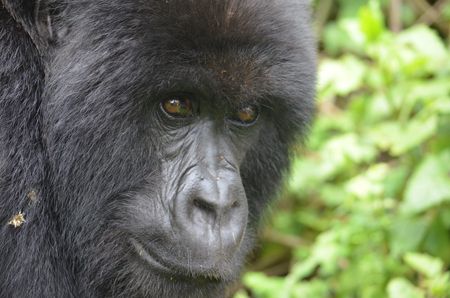Inside Rwanda's Mountain Gorilla Project
An inside look at what it's like treating mountain gorillas in Africa.

There are only an estimated 780 mountain gorillas on the planet, and they're found in the rich mountain forests of the Democratic Republic of Congo (DRC), Uganda, and Rwanda. In Rwanda, veterinarians are playing a significant role in saving them-and so do tourists. “Our job is to improve the sustainability of the mountain gorillas,” says Dr. Dawn Zimmerman, regional manager of the non-profit Mountain Gorilla Veterinary Project. Zimmerman presented to a group of eco tourists traveling with Terra Incognita Ecotours at the Virunga Lodge in Rwanda before we trekked to see the gorillas.
While a civil war and a lack of infrastructure keep most Western tourists out of the DRC, about 1,900 tourists visited Uganda and Rwanda to see the gorillas in 2011. Each tourist gets 60 minutes with a habituated gorilla group and up to eight tourists can visit at a time. Rwanda's economy benefits from the tourism to the tune of about $250 million annually. And in Rwanda, there are about 250 gorillas, so that makes each gorilla worth a cool million to the country's needy economy. Those dollars go toward much more than saving gorillas-the money creates jobs (porters, trekkers, and guides as well as those who work at the Virunga Lodge) and some dollars are invested in a local school not far from where the gorillas live. So, despite population pressures for valuable land to farm and live on, Rwanda and Uganda are adamant about protecting mountain gorillas and the places where they live. In turn, this protects other plants and animals in the forests, including the rare golden monkeys. Still there are threats.
While Rwanda and Uganda have pretty much eliminated poaching, Zimmerman says traps are sometimes set for small antelope species. Incredibly, some gorillas have learned to dismantle the snares, but other gorillas get caught in them. That's when Zimmerman and her team head out to free entrapped gorillas and treat resulting wounds. Dr. Mike Cranfield, co-director of the Mountain Gorilla Project, says that gorillas must be treated in their forest homes-there's no nearby emergency facility to transport a 450-pound gorilla. Treatment must be quick. “The snares can cut circulation off, and sometimes parts of limbs require an amputation,” Cranfield says. “The goal is to prevent life threatening infections. For all animals we treat, even for gorillas that may be injured falling from a tree, we take blood samples so we can better understand them. And we have a gorilla blood bank.” However, the most significant threat to mountain gorillas may originate from the eco tourists who ultimately provide for their protection. Zimmerman says being such a close relative to people, gorillas are susceptible to many of the same viruses and infectious disease that we are, and often more susceptible since they don't have any immunity to these things.
If you think treating a fractious cat is problem, what about a 450-pound male silverback? While the peaceful gorillas go about their business eating, sleeping, and playing when tourists observe them-mostly as if the visitors were invisible-the same is not true when the veterinarians appear. Somehow they know the veterinarians are not like the other tourists. The see and smell the medical equipment. What they don't completely understand is that the doctors are there to help. Those enormous and intimidating silverbacks defend their troop, and mothers protect their babies. Zimmerman says when a silverback charged her, and she stood her ground-not an easy thing to do with an angry male gorilla running right at you. “I could feel his breath on my face.” On another occasion, a veterinarian treated a gorilla's hand. Later the veterinarian returned to follow up, and the silverback extended the once injured hand as if to show, “It's okay now.”
Our group of gorilla trekking tourists included Dr. Jeanne Potter, a San Diego veterinarian. She was impressed with the gorilla doctors. “The necropsies they conduct on each gorilla will not only help us understand gorillas but also might benefit the one-health initiative since gorillas could be a sentinel for some still to be identified emerging disease,” she says. The veterinarians' efforts are working. Cranfield says the mountain gorilla population has increased 26 percent over the past seven years. “Though computer modeling we believe the veterinary work has produced half of that increase,” he says. But the mountain gorillas, which are not found in captivity, remain vulnerable. They live in isolated populations with limited land area due to burgeoning populations and farmland. While the conservation efforts are important, there are ethical issues to deal with. When should the gorilla veterinarians-who are now mostly African veterinarians-intercede rather than let nature run its course? Cranfield admits they don't have all the answers. The University of California, Davis now oversees the program, but it's also a not-for-profit.
tTo learn about how you can help or to make a donation, visit gorilladoctors.org.